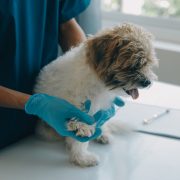ACVIM consensus statement on diagnosis and management of urinary incontinence in dogs
ACVIM consensus statement on diagnosis and management of urinary incontinence in dogs

Open access
In our edition of: Apr 2024
In our categories of: small animals
our summary:
Kendall, A. et al. (2024) ACVIM consensus statement on diagnosis and management of urinary incontinence in dogs. Journal of Veterinary Internal Medicine¸ 38 (2), pp. 878-903.
The aim of this consensus statement was to provide guidance on the diagnostic testing and management of urinary incontinence (UI) in male and female dogs.
Using the standard methodology for ACVIM consensus statements, a panel of 12 experts (eight small animal internists, two neurologists, one radiologist and one surgeon) with input from members of the American Society of Veterinary Nephrology and Urology, assessed the evidence and agreed on consensus clinical recommendations using the Delphi method.
The evidence review and recommendations are presented under the following headings: classification, diagnostics, treatment, gonadectomy, follow-up and monitoring.
The guidelines emphasise the importance of obtaining a thorough history from the client, undertaking direct observation, and completing a physical examination for all dogs with UI. The physical examination should include a rectal examination with urethral palpation, bladder palpation, and focused neurological examination that assesses behaviour, gait, hindlimb postural reactions, spinal reflexes, tail tone and presence or absence of back pain. The importance of identifying any patterns is also emphasised as this will enable management strategies to be tailored to the individual dog.
The majority of recommendations reached 100% consensus, areas where there was not 100% consensus include: the use of flexible cystoscopy in the diagnostic evaluation of male dogs with conditions with inappropriate urine storage that have failed to respond to phenylpropanolamine before treatment with testosterone, use of additional medications e.g. parasympathomimetics to increase bladder contractability in dogs diagnosed with functional outflow obstruction and without chronic bladder over-distension, and use of oxybutynin for dogs that have not responded to standard urethral sphincter mechanism incompetence treatment that have a urination pattern consistent with detrusor instability.
Areas highlighted for further study include increased understanding of the underlying pathophysiology of UI particularly in male dogs, the prevalence of storage or voiding disorders and controlled clinical trials that make direct treatment comparisons.
Limitations include the lack of clarity on the search strategy used to identify papers for inclusion and the methods used for evaluating published literature were unclear.
This consensus statement provides practitioners with an overview of the current knowledge on urinary incontinence in male and female dogs, as well as clear recommendations on the diagnosis and management of the disorder.
The following may also be of interest:
InFOCUS: Spaying and urinary incontinence in bitches under UK primary veterinary care: a case–control study [RCVS Knowledge] [online] Available from: https://infocus.rcvsknowledge.org/spaying-and-urinary-incontinence-in-bitches-under-uk-primary-veterinary-care-a-case-control-study/ [Accessed 11 April 2024]
InFOCUS: Associations between neutering and early‐onset urinary incontinence in UK bitches under primary veterinary care [RCVS Knowledge] [online] Available from: https://infocus.rcvsknowledge.org/associations-between-neutering-and-early-onset-urinary-incontinence-in-uk-bitches-under-primary-veterinary-care/ [Accessed 11 April 2024]
InFOCUS: International Society for Companion Animal Infectious Diseases (ISCAID) guidelines for the diagnosis and management of bacterial urinary tract infections in dogs and cats [RCVS Knowledge] [online] Available from: https://infocus.rcvsknowledge.org/international-society-for-companion-animal-infectious-diseases-iscaid-guidelines-for-the-diagnosis-and-management-of-bacterial-urinary-tract-infections-in-dogs-and-cats/ [Accessed 11 April 2024]
Claiming CPD for reading inFOCUS articles
Reading and reflecting on articles can count towards your CPD, and we have a template to help you with the process.
Image copyright attribute: rguryca







Leave a Reply
Want to join the discussion?Feel free to contribute!